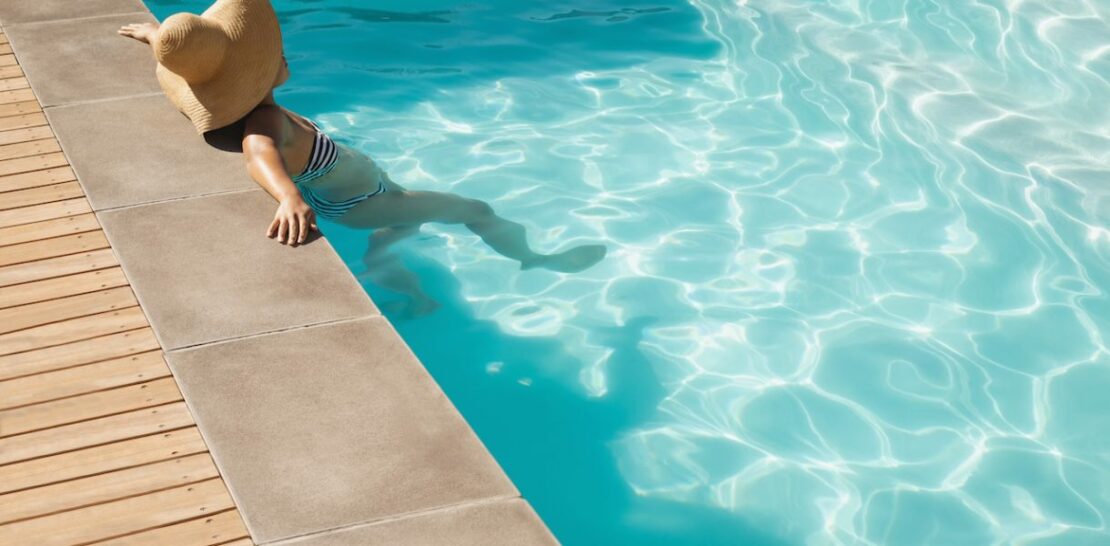Every pool owner dreams of having a crystal-clear pool that is not only inviting but also safe and healthy for swimmers.
However, maintaining a pristine pool can seem like an overwhelming task, especially with the myriad of information and advice available.
In this comprehensive guide, we will simplify the process and provide you with five essential tips for achieving and maintaining a gleaming, crystal-clear pool that you can be proud of.
From understanding the importance of pool circulation to mastering the art of proper chemical balance, this article will serve as your go-to resource for all things pool maintenance.
1. Optimize Pool Circulation for Impeccable Clarity
One of the most critical aspects of maintaining a clear pool is ensuring optimal water circulation. Proper circulation ensures that chemicals are evenly distributed throughout the pool and helps to prevent the growth of algae and bacteria.
There are several key components that contribute to efficient pool circulation, including:
- Pool Pump: The pool pump is the heart of the circulation system, drawing water from the pool and pushing it through the filter before returning it to the pool. To ensure optimal circulation, it’s essential to select a pump that is appropriately sized for your pool and to run it for an adequate amount of time each day. As a general rule, the entire volume of the pool should be circulated at least once every 24 hours.
- Pool Filter: The filter is responsible for removing debris and particulates from the water, helping to maintain clarity. There are three primary types of pool filters: sand, cartridge, and diatomaceous earth (DE). Each type has its own maintenance requirements, but it’s essential to clean or replace the filter media regularly to ensure optimal performance.
- Pool Skimmer and Returns: Skimmers and returns play a vital role in circulating the water at the pool’s surface, where most debris and contaminants are found. Keep skimmer baskets clean and ensure that returns are positioned to create a gentle, circular movement of water around the pool for optimal surface circulation.
By maintaining these critical elements of your pool’s circulation system, you’ll be well on your way to achieving crystal-clear water.
2. Implement a Consistent and Thorough Cleaning Routine
Another essential aspect of maintaining a clear pool is implementing a consistent and thorough cleaning routine. This includes regularly removing debris, brushing the pool surfaces, and vacuuming the pool floor.
The following cleaning tasks should be incorporated into your routine to maintain a spotless pool environment:
- Remove Surface Debris: Use a skimmer net to remove leaves, insects, and other floating debris from the water’s surface daily. This will not only improve the pool’s appearance but also reduce the amount of organic material that can contribute to algae growth and cloudy water.
- Brush Pool Surfaces: At least once a week, use a pool brush to scrub the walls, floor, and steps of the pool. This will help to dislodge algae and other contaminants that can contribute to cloudiness and staining.
- Vacuum the Pool: Regularly vacuuming the pool floor will remove settled debris and dirt, helping to maintain water clarity and reduce the demand on the pool filter. Manual pool vacuums are an affordable option, but automatic pool cleaners can save time and effort by doing the job for you.
- Clean the Pool Filter: As mentioned earlier, the pool filter plays a crucial role in maintaining water clarity. Be sure to follow the manufacturer’s guidelines for cleaning or replacing the filter media to ensure optimal performance.
By committing to a consistent and thorough cleaning routine, you’ll be taking a proactive approach to maintaining a crystal-clear pool.
3. Master the Art of Proper Chemical Balance
Maintaining the correct chemical balance in your pool is crucial for ensuring water clarity, as well as the health and safety of swimmers. An imbalance in pool chemistry can lead to a range of issues, including cloudy water, algae growth, and damage to pool equipment and surfaces.
To master the art of proper chemical balance, you’ll need to regularly test and adjust the following parameters:
- pH: The pH level measures the acidity or alkalinity of the water, with a pH of 7.0 being neutral. A pH range of 7.2 to 7.6 is ideal for pools, as this helps to ensure optimal sanitizer effectiveness and prevents damage to pool surfaces and equipment. Test the pH at least once a week and adjust as necessary using pH increasers (such as soda ash) or decreasers (such as muriatic acid or sodium bisulfate).
- Alkalinity: Total alkalinity measures the water’s ability to buffer pH changes, helping to maintain a stable pH level. The ideal total alkalinity range for pools is between 80 and 120 parts per million (ppm). Test and adjust alkalinity levels as needed, using alkalinity increasers (such as sodium bicarbonate) or decreasers (such as muriatic acid).
- Sanitizer: Sanitizers, such as chlorine or bromine, are essential for killing bacteria, algae, and other contaminants in the pool water. Maintaining the proper sanitizer level is crucial for ensuring water safety and clarity. For chlorine pools, aim for a free chlorine level of 1 to 3 ppm, and for bromine pools, aim for a level of 3 to 5 ppm. Test and adjust sanitizer levels frequently, especially during periods of heavy pool use or after rainstorms.
- Calcium Hardness: Calcium hardness refers to the concentration of calcium ions in the water, which can affect the water’s ability to dissolve and hold minerals in solution. High calcium hardness levels can lead to cloudy water, scaling, and damage to pool surfaces and equipment, while low levels can result in etching and corrosion. The ideal calcium hardness range for pools is between 200 and 400 ppm. Test and adjust calcium hardness levels as needed, using calcium increasers (such as calcium chloride) or decreasers (such as a sequestering agent).
By staying vigilant with your pool’s chemical balance, you will prevent many common water clarity issues and ensure a safe swimming environment for all.
4. Combat Algae Growth with Proactive Measures
Algae are microscopic plants that can thrive in pool water, leading to unsightly green, yellow, or black growths on pool surfaces and cloudy water. To maintain a crystal-clear pool, it’s essential to take proactive measures to prevent and eliminate algae growth.
Implement the following strategies to keep algae at bay:
- Maintain Proper Sanitizer Levels: As mentioned previously, maintaining the appropriate sanitizer level is crucial for killing algae and preventing its growth. Be sure to test and adjust sanitizer levels frequently, particularly during periods of heavy pool use or after rainstorms.
- Regularly Brush and Vacuum Pool Surfaces: Algae can cling to pool surfaces, making it difficult for sanitizers to reach and kill them. Regular brushing and vacuuming of pool surfaces will help to dislodge and remove algae, keeping your pool clean and clear.
- Utilize Algaecides: Algaecides are specialized chemicals designed to kill and prevent algae growth. Use algaecides as a preventative measure, following the manufacturer’s guidelines for frequency and dosage.
- Address Phosphates: Phosphates are a primary food source for algae, and high phosphate levels in pool water can contribute to persistent algae growth. Test for phosphates regularly and use a phosphate remover if necessary to reduce their concentration and discourage algae growth.
By taking these proactive measures against algae growth, you’ll be well-equipped to maintain a pristine, algae-free pool environment.
5. Practice Effective Water Management
Finally, effective water management is crucial for maintaining a crystal-clear pool. This involves understanding the environmental factors that can affect your pool’s water quality and taking steps to mitigate their impact.
Consider the following water management practices to promote optimal pool clarity:
- Limit Debris: Reduce the amount of debris that enters your pool by keeping the surrounding area clean and using pool covers when the pool is not in use. This will minimize the amount of organic material that can contribute to cloudy water and algae growth.
- Control Runoff: Ensure proper drainage around your pool to prevent rainwater runoff from introducing contaminants, such as fertilizers and pesticides, into the pool water. This will help to maintain water clarity and prevent algae growth.
- Prevent Oil and Lotion Buildup: Encourage swimmers to shower before entering the pool to remove excess oils and lotions, which can contribute to water cloudiness andthe formation of a scum line around the pool’s edge. Consider using enzyme-based pool water treatments to break down oils and organic contaminants, further promoting water clarity.
- Manage Water Temperature: Warmer water temperatures can promote algae growth and increase the rate at which sanitizers are consumed. Maintain a water temperature of around 78°F to 82°F for optimal water clarity and sanitizer efficiency.
- Perform Regular Water Testing: In addition to testing for chemical balance, regularly test your pool water for contaminants, such as metals and phosphates, that can contribute to water cloudiness and staining. Use appropriate chemical treatments to address any issues that are identified through water testing.
- Partial Water Replacement: Over time, the water in your pool can become saturated with dissolved solids, making it more challenging to maintain water clarity and balance. Periodically replacing a portion of your pool water with fresh water can help to mitigate this issue and promote optimal water quality.
By implementing these effective water management practices, you’ll be taking a comprehensive approach to maintaining a crystal-clear pool that is both visually stunning and healthy for swimmers.
In conclusion, achieving and maintaining a crystal-clear pool may seem like a daunting task, but by following these five essential tips, you’ll be well on your way to enjoying a pristine pool environment. Remember to optimize pool circulation, implement a consistent and thorough cleaning routine, master the art of proper chemical balance, combat algae growth with proactive measures, and practice effective water management. Doing so will not only result in a gleaming, inviting pool but also ensure a safe and healthy swimming experience for all. So, dive in and enjoy the sparkling clean water that your pool has to offer!




